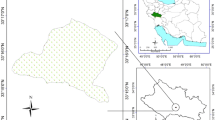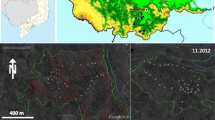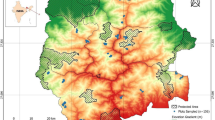Abstract
We assessed the diversity of woody plants at 15 forested sites in the Tansa Valley of Thane District, in Maharashtra, India. The fewest species (11) were seen at a degraded mangrove site near the river mouth, and the greatest number (150) in the rich semi-evergreen forest on Tungar Hill. For all sites there were 141 tree, 25 shrub and 15 liana species, a total of 181 species. Excluding the mangrove site, which had no species in common with the other 14 sites, we analyzed the species distributions in detail. These sites ranged in area from 4 to 30 km2 each, had woody floras of 89 ± 6 species, and varied in intensity of human impact. Despite a history of exploitation and substantial reduction in biomass from firewood collecting, set fires and illicit tree felling, considerable plant diversity remains in the area. We found a modest increase in species richness in transects away from two villages. We observed the exploitation of the forest by the principal users, primarily of the Warli Tribe. They exploited a wide variety of forest resources (92 species), for medicines, foods, construction materials, household goods, manure and other purposes. They collected 15 items for sale. By far the single most important item collected was firewood, which dramatically reduced forest biomass within 2 km of villages. The species distributions in these forest remnants are strongly nested, mostly due to varying degrees of disturbance at individual sites. The high species diversity on Tungar Hill is most likely a relict of the earlier character of forests throughout much of the valley. It merits the highest priorities for preservation, as a refuge for Western Ghat species at the northern limits of their distributions.
Similar content being viewed by others
References
Almeida M.R. 1996-1998. The Flora of Maharashtra. Vols. 1 and 2. Orient Press, Mumbai, India.
Ambasta S.P. (ed.) 1986. The Useful Plants of India. Publications and Information Directorate, Council of Scientific and Industrial Research, New Delhi, India.
Anonymous 1982. Maharashtra State gazetteers. Thane District. Gazetteers Department of the Government of Maharashtra, Bombay, India.
Anonymous 1998. Karjat: adivasi vaidyak parampara. Academy of Development Science, Karjat, Maharashtra, India.
The Angiosperm Phylogeny Group (APG) 1998. An ordinal classification for the families of flowering plants. Annals of the Missouri Botanical Garden 85: 531–553.
Atmar W. and Patterson B.D. 1993. The measure of order and disorder in the distribution of species in fragmented habitat. Oecologia 96: 373–382.
Atmar W. and Patterson B.D. 1995. The Nestedness Temperature Calculator: AVisual Basic Program. AICS Research, Inc., University Park, New Mexico, and the Field Museum, Chicago, Illinois.
Ballal M. 2000. Felling of Trees Depletes Thane's Forest Cover. Times of India, Bombay, India, March 30.
Banerjee S.C. 1980. Flora and Fauna in Sanskrit Literature. Naya Prokash, Calcutta, India.
Billore K.V. 1972. The vegetation and flora of Thana District, Maharashtra State, Ph.D. Thesis, Ujjain University, Madhya Pradesh, India.
Brown J.V. and Lomolino M.V. 1998. Biogeography. 2nd edn. Sinauer Associates, Sunderland, Massachusetts.
Campbell J.M. 1882. Gazetteer of the Bombay Presidency. Thana, Volume XIII, Part II. Government Central Press, Bombay, India.
Champion H.G. and Seth S.K. 1968. A Revised Survey of the Forest Types of India. Manager of Publications, Government of India, Delhi, India.
Chandrashekara U.M. and Ramakrishnan P.S. 1994. Vegetation and gap dynamics of a tropical wet evergreen forest in the Western Ghats of Kerala, India. Journal of Tropical Ecology 10: 337–354.
Cook R.R. and Quinn J.F. 1998. An evaluation of randomization models for nested species subset analysis. Oecologia 113: 584–592.
Cooke T. 1904. Flora of the Presidency of Bombay, two volumes. Taylor and Francis, London.
Ganesh T., Ganesan R., Soubadra Devy M., Davidar P. and Bawa K.S. 1996. Assessment of plant biodiversity at a mid-elevation evergreen forest of Kalakad-Mundanthurai Tiger Reserve, Western Ghats, India. Current Sciences 71: 379–391.
Gaulier A., Pascal J.P. and Puyravaud J.P. 1995. Assessing vegetation changes in the dry deciduous Ainurmarigudi Reserve Forest, South India. Annales Des Sciences Foresteries 52: 444–454.
Gaussen H., Legris P., Labroue L., Meher-Homji V.M. and Viart M. 1966. Notice de la feuille. Bombay Travaux de la Section Scientifique et Technique, L'Institut Français Pondichéry, Hors Série No. 8.
Gentry A.H. 1995. Diversity and floristic composition of neotropical dry forests. In: Bullock S.H., Mooney H.A. and Medina E. (eds), Seasonally Dry Tropical Forests. Cambridge University Press, New York, pp. 146–194.
Honnay O., Hermy M. and Coppin P. 1999. Nested plant communities in deciduous forest fragments: species relaxation or nested habitats? Oikos 84: 119–129.
Jonsson B.G. 2001. A null model for randomization tests of nestedness in species assemblages. Oecologia 127: 309–313.
Koshy K.C. and Shah G.L. 1987. A contribution to the angiosperm flora and vegetation of Mandvi and Gokhirva forest ranges in Maharashtra. Journal of Economic and Taxonomic Botany 10: 79–124.
Legendre P. and Legendre P. 1998. Numerical Ecology. 2nd English edn. Elsevier, Amsterdam.
Legris P. and Meher-Homji V.M. 1977. Phytogeographic outlines of the hill ranges of peninsular India. Tropical Ecology 18: 10–24.
Legris P. and Meher-Homji V.M. 1979. The Deccan trap country and its vegetation patterns. Bulletin of the Indian Natural Sciences Academy 45: 108–126.
Leuschner C. 1996. Timberline and alpine vegetation on the tropical and warm-temperate oceanic islands of the world: elevation, structure and floristics. Vegetatio 123: 193–206.
Lott E.J., Bullock S.H. and Solis-Magallanes J.A. 1987. Floristic diversity and structure of upland and arroyo forests of Coastal Jalisco. Biotropica 19: 228–235.
Mabberley D.G. 1998. The Plant Book. 2nd edn. Cambridge University Press, Cambridge, UK.
Meher-Homji V.M. 1979. A biometeorological assessment of climate: case studies of Bombay and Mercara. Indian Geographical Journal 54: 43–54.
Parthasarathy N. 1999. Tree diversity and distribution in undisturbed and human-impacted sites of tropical wet evergreen forest in southern Western Ghats, India. Biodiversity and Conservation 8: 1365–1381.
Parthasarathy N. and Sethi P. 1997. Tree and liana species diversity and population structure in a tropical dry evergreen forest in south India. Tropical Ecology 38: 19–30.
Pascal J.P. 1986. Explanatory booklet on the forest map of South India. L'Institut Français de Pondichery, Trav. Sect. Scient. Tech., Hors Seriée no. 18.
Pascal J.P. and Pelissier R. 1996. Structure and floristic composition of a tropical evergreen forest in southwest India. Journal of Tropical Ecology 12: 191–214.
Pereira A.B. 1935. Os Portugueses em Baçaim. Tipografia Rangel, Bastorá, Portugal.
Rai S.N. 2000. Productivity of Tropical Rain Forests of Karnataka. Punarvasu Publications, Dharwad, Karnataka, India.
Ranta P., Tanskanen A., Niemelä J. and Kurtto A. 1999. Selection of islands for conservation in the urban archipelago of Helsinki, Finland. Conservation Biology 13: 1293–1300.
Rundel P.W. and Boonpragob K. 1995. Dry forest ecosystems of Thailand. In: Bullock S.H., Mooney H.A. and Medina E. (eds), Seasonally Dry Tropical Forests. Cambridge University Press, New York, pp. 93–123.
Santapau H. 1954. The flora of Khandala on theWestern Ghats of India. Records of the Botanical Survey of India 16: 1–396.
Santapau H. and Randeria A.J. 1970. The botanical exploration of the Krishnagiri National Park, Borivli, near Bombay. Journal of the Bombay Natural History Society 53: 185–200.
Satyanarayan Y. 1959. Ecological studies of the Elephanta Island. Travaux Sect. Scient. Tech., Institut Français de Pondichery 1: 99–116.
Save K.J. 1945. The Warlis. Padma Publications, Bombay, India.
Stebbing E.P. 1922. The Forests of India, Vol. 3. John Lane, London.
Talbot W.A. 1894. Systematic List of the Trees, Shrubs and Woody Climbers of the Bombay Presidency. Government Central Press, Bombay, India.
Tucker R. 1979. Forest management and imperial politics: Thana District, Bombay, 1823-1887. Indian Economic and Social History Review 16: 273–300.
Whitmore T.C. 1984. Tropical Rain Forests of the Far East. Oxford University Press, Oxford, UK.
Rights and permissions
About this article
Cite this article
Veach, R., Lee, D. & Philippi, T. Human disturbance and forest diversity in the Tansa Valley, India. Biodiversity and Conservation 12, 1051–1072 (2003). https://doi.org/10.1023/A:1022834722091
Issue Date:
DOI: https://doi.org/10.1023/A:1022834722091




